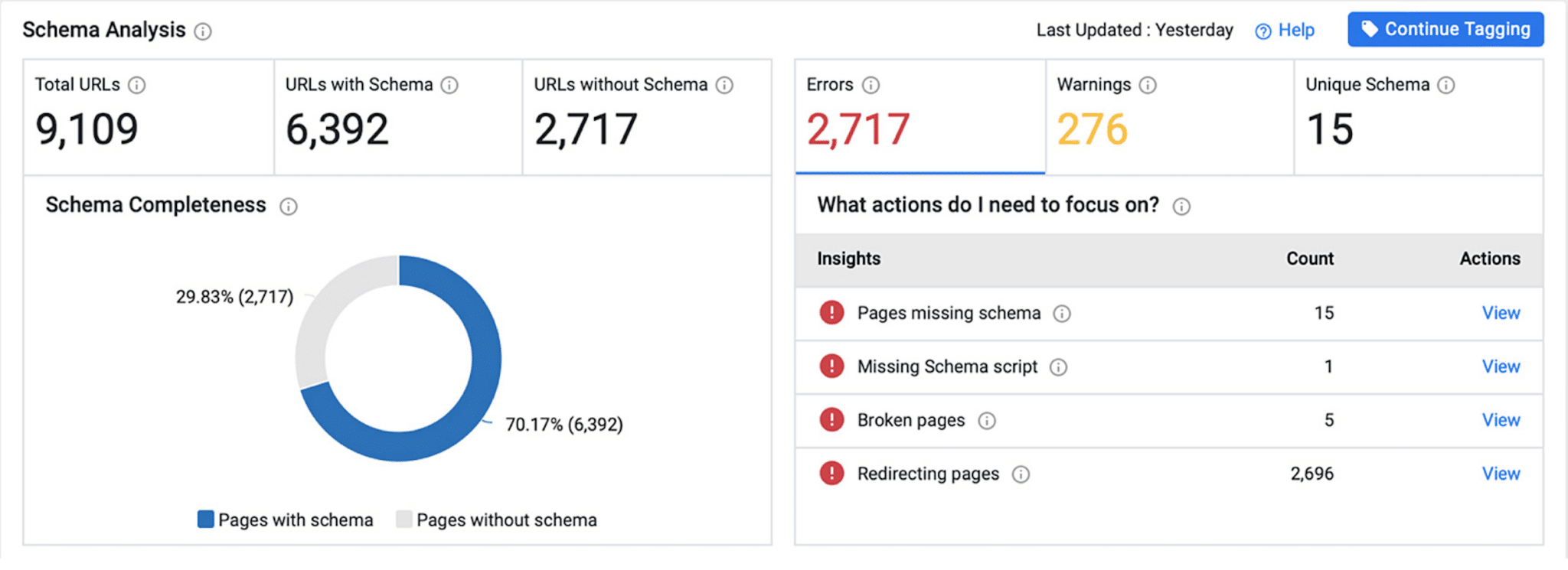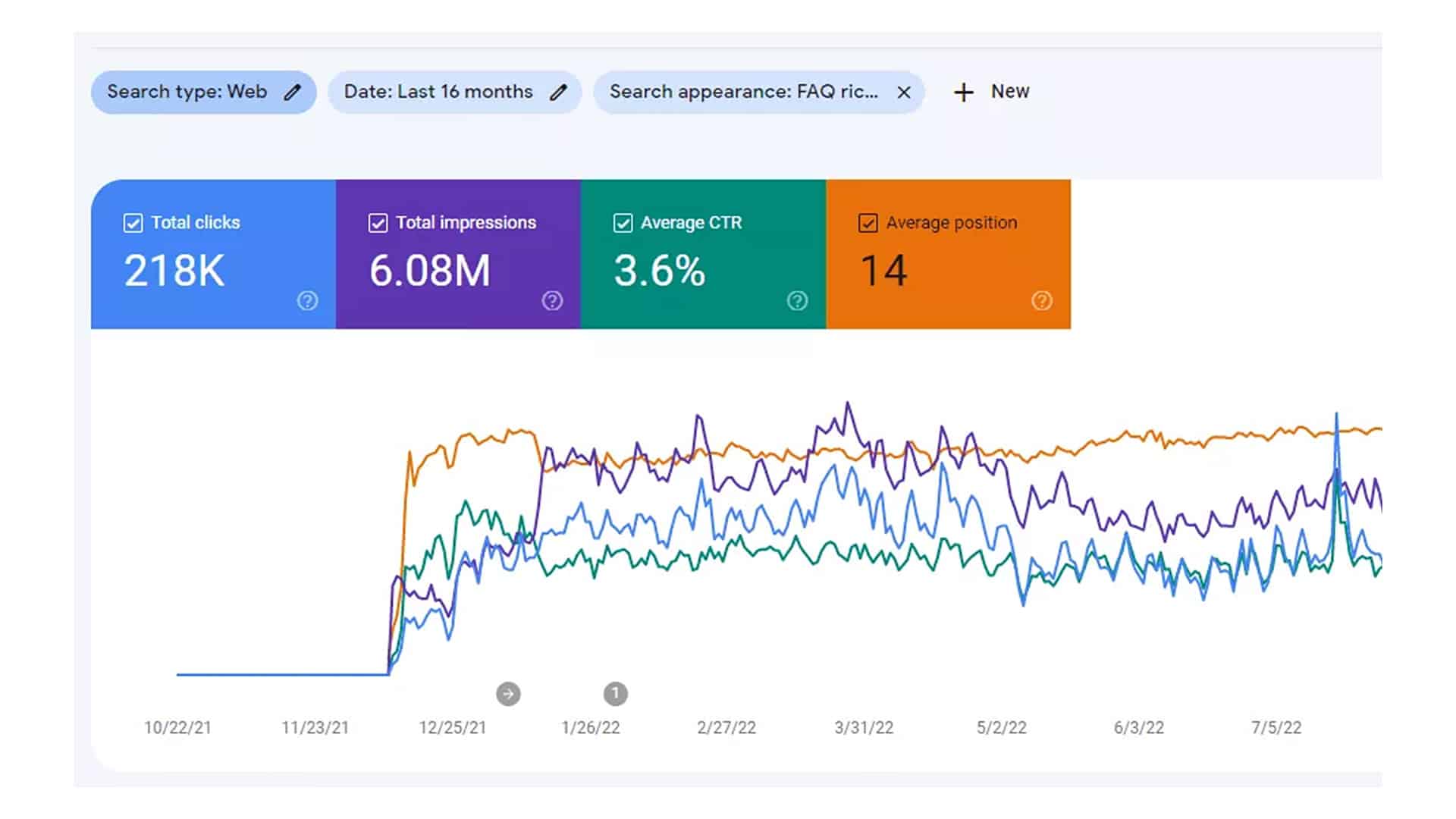How to measure schema performance
We know that schema helps harness the power of your content by making it more discoverable in search results.
Our last article, How to deploy advanced schema at scale, covered the schema deployment and maintenance process. The next step is to track the performance of your schema.
This article will discuss the KPIs for measuring the impact of schema deployment, ways to monitor schema errors, and how to analyze your content’s SERPs performance.
Setting up the right measurement steps and metrics
These two steps are critical when it comes to measuring your schema performance:
- Schema analysis: Assess the schema deployed on various high-performing assets such as URLs, images, videos, FAQs, etc.
- Identifying the right KPIs to measure: This includes impressions, clicks, CTR, SERPs saturation, and potential cost savings.
Analyzing deployed schema
Schema analysis is essential for identifying the right assets for large websites. Ideally, schema should be deployed on critical assets like images, pages, videos, FAQs, menus, etc.
Schema opportunities need to be checked constantly because of the dynamic nature of URLs. Keep in mind schema can only be deployed if your pages are accessible.
I suggest running a ScreamingFrog crawl to find all the URLs returning 200 OK codes.
As part of schema analysis, ensure it covers all essential available assets and URLs on your website.
Constant completeness checks
Schema deployment should never be a one-time activity.
As a large site’s content gets updated, so should the schema being deployed.
All redirects, broken URLs, and pages that are missing schema should be constantly reviewed to ensure your content is discoverable.
Read Google Search Central’s help documentation on deploying and maintaining the right schema types.
Below is a robust dashboard that helps understand the important schema analysis and tracking stages.

Catching schema drifts and errors
If your schema is flagged for errors, address them immediately to avoid manual action from Google.
Schema drifts are errors due to schema vocabulary changes in schema.org or Google’s rich result guidelines, website content changes and other technical issues.
If the schema drift is caused by website content or vocabulary changes, the schema deployed must be changed before search engines index those pages.
Analyzing content changes and setting up triggers or notifications as a reminder to change schema can be helpful.
Once you’ve analyzed your schema deployment strategy, it’s time to track your schema KPIs.
Get the daily newsletter search marketers rely on.
See terms.
Identifying the right KPIs to measure the impact of schema deployment
Below are strategic KPIs you should use to gauge the performance of your schema and the effectiveness of its implementation:
Impressions
With schema influencing rich results, content discovery becomes accessible.
High-value content is discovered easier in the SERPs.
As a result, you will see higher impressions for all your zero-click results and all other results relevant to the user query.
Content targeting long-tail queries is also easily discovered, providing the most valuable results on the page.
Clicks
Are you driving traffic to your business profile or website?
Clicks determine how many users decided to take action after discovering your content.
A good KPI to gauge is the total clicks you earned post-schema deployment.
It is necessary to assess to see if the schema is helping content discovery and driving relevant results for your content over time.
Note that whenever your schema drives rich results, this will spike your impressions more than your clicks.
If your clicks are not increasing as much as your impressions, you should not worry because your content is helpful and gives the right results based on the query type.
In the image below, you’ll see that after deploying schema, KPIs such as clicks, impressions, CTR and average position also went up.

Click-through rate (CTR)
CTR is also an important KPI to watch as this is a division of the clicks your content has earned from search by the total number of impressions.
High or low CTR is based on your content strategy.
If the content is written for awareness, then CTR will be low, and if the content is written for conversion, then CTR will be high.
Average CPC
You’re probably wondering why cost per click, a measurement for paid campaigns, is required here.
Knowing how much your business will need to spend to drive the visibility of keywords is essential.
It will help you determine the amount your business saves organically just by deploying schema.
Potential cost savings
Calculate the CPC of those keywords to see if you’ve saved money using schema implementation instead of opting for paid campaigns.
This will help you gauge the value of implementing schema on your website.
SERPs coverage / rich results
SERP coverage refers to the types of universal search results you’ve appeared in.
Once you’ve deployed schema for your various assets, the easiest way to gauge its impact is to measure SERP coverage in universal results.
Measure different types of SERPs (based on the schema you’ve deployed), including images, FAQ, video, content, People Also Ask, etc.

SERP coverage can inform your content strategy.
If the content pieces you created and tagged do not show up in some of these results, the content might not be relevant or helpful.
Suppose you’ve deployed FAQs or HowTo schema for the visibility of conversational content.
In that case, you’ll need to watch the performance of your FAQ, People Also Ask, and even Featured Snippets rich results after deployment to see if there is a visibility lift.
Similarly, look at the rich results that don’t appear in the SERPs.
For example, your images aren’t performing as well as you’d like.
Formulate a schema strategy to drive the visibility of those entities or assets on your webpages.
Performance of each schema type and combinations
Schema types are not equal. Some are used to give search engines context, while others drive rich results that can impact performance significantly.
It is important to drill down and see which schema types are most effective based on your content strategy.
Use Google Search Console to see which schemas are showing up and driving search visibility.
Evaluating the impact of schema deployment on your website
Schema maintenance and performance measurement go hand in hand. It’s a cyclic process.
Once you know how your schemas fare, it’s time to expand schema deployment across other parts of your website.
Now that you know which schemas work to boost your search visibility, you can finetune your overall schema strategy.
The post How to measure schema performance appeared first on Search Engine Land.







Recent Comments